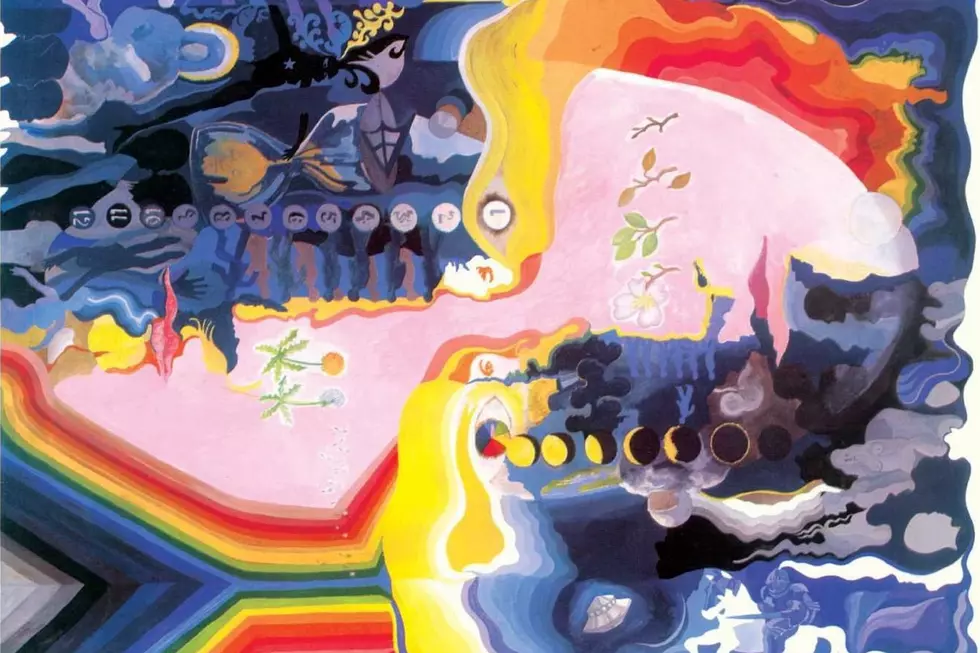
How Moody Blues Broke the Rules on ‘Days of Future Passed’
The Moody Blues secured their place in prog history as Days of Future Passed shot up the U.K. rock charts. But the project, released on Nov. 10, 1967, was fraught with deep uncertainty, weird happenstance and then – at least in the U.S. – initial lack of interest.
The Moody Blues had started out as a rootsy band, as far removed from symphonic rock as they could be. "We were originally a rhythm-and-blues band, wearing blue suits and singing about people and problems in the Deep South," frontman Justin Hayward told the Los Angeles Times in 1990. "It was okay, but it was incongruous, getting us nowhere, and in the end we had no money, no nothing."
Then came what Hayward says was "a series of wonderful accidents." Their label, Decca Records, was looking to recoup money it had advanced the Moody Blues, while promoting then-new stereo recording equipment that produced the so-called Deramic Sound. Already a hit with classical listeners, Decca was hoping stereo would take off with the rock crowd, as well.
"Up until that time, most albums, of course, were only in glorious mono," bassist John Lodge told the St. Petersburg Times in 2000. "Later, we had to actually go back into the studio and remix it into mono, because so many people wanted it in mono. They didn't have stereo players."
Decca suggested blending classical and rock ideas, in the hopes of speaking to both audiences.
"They wanted us, as a way to pay off that debt, to do a demonstration record of a rock version of Dvorak with [conductor] Peter Knight playing the real Dvorak between our pieces and an engineer mixing them together so people would say, 'Oh, that sounds wonderful in stereo,'" Hayward noted on the Moody Blues' official site in 2012. Producer “Michael Barclay, whose project it was to get these demonstration records together, suggested we do it the other way around: We do our songs and then Peter Knight would orchestrate pieces in between our songs, and so that's what we did."
It was a stroke of genius – or, more correctly, a stroke of accidental genius. Through sheer force of will, the Moody Blues created the perfect vehicle for a groundbreaking combination. "We said, yeah, sure we'd do it," Hayward told the Los Angeles Times, "and then, after we said yes, we went down to the pub and decided to do our own songs instead."
Listen to the Moody Blues' 'The Day Begins'
The Moody Blues had been developing an album-length theme that used the elements of a passing day as a metaphor for phases of life. They'd build off a track already written by keyboardist John Pinder titled "Dawn of a Feeling," leveraging the entire project – eventually, that is – on "Nights in White Satin."
Hayward used the song to explore the ending of one love affair and the beginning of another, keying on the image of a set of new sheets he'd just been given. "I just sat down at the edge of the bed with my big 12-string and wrote the song in like four minutes," Hayward told the Pittsburgh Post-Gazette in 1999. "I think there's a lot of truth in it."
He took the same 12-string into rehearsal the next day to play "Nights in White Satin" for his bandmates. "They sort of went 'Oh, yeah, it's alright,'" Hayward added, laughing.
But then Pinder said, "Play it again, Justin," and began to add Mellotron accompaniment. Once he created the now-familiar harmony line on the keyboard, they knew they'd hit upon something magical. "Fairy dust. The invisible, unknowable thing," drummer Graeme Edge told the Naples Daily News in 2012. "It's just one of those songs where everything came together correctly."
That was true for the entire project, as these new tracks alternated with interludes from the London Festival Orchestra. The two groups' peak collaboration arrived during the soaring conclusion of "Nights in White Satin."
"It took us five days to finish, and, after each day we'd send them down to Peter Knight, and he'd write these orchestral arrangements," Hayward told the Los Angeles Times. "We'd edited all the tapes to be the right length, and [the orchestra] just played live in the gaps."
By the end, they'd taken the then-nascent idea of rock concept albums to an entirely new level. "It was revolutionary," Lodge told the St. Petersburg Times. "Usually an album was six hit singles and six B-sides of songs that people didn't particularly want to listen to. We put it together as an album, 40 minutes of real music. That's why there's no stops, no scrolls, in Days of Future Passed. One song goes into the next song. It goes through as a complete work of art."
Thing is, Decca didn't know about any of it. The Moody Blues didn't present Days of Future Passed until the entire recording was complete. "It was a conspiracy among all us musicians who were present," Hayward admitted in his talk with the Los Angeles Times.
Listen to the Moody Blues' 'The Afternoon'
The label executives were, by and large, nonplussed. "When we played the finished product to all these old directors at Decca – which is a fine, upstanding old English music firm – they said, 'This isn't Dvorak,'" Hayward added, "and we said, 'No, but this is what it is.'"
In another happy twist, it turned out that the Moody Blues had a lone ally. "Fortunately, a guy from the States was there, called Walt Maguire," flautist Ray Thomas told the Hit Channel in 2016. "He was the head of London Records, which was Decca America, and he said, 'If they don’t want it, I certainly do. This is going to blow up our sales in the States.' So, that’s how it got released."
All that was left to do was to wait and see just who might be attracted to the Moody Blues' previously unheard synthesis. "We all thought we were making some sort of limited-appeal art record, that we'd get invited to a few sort of champagne parties and get into highbrow papers, as they were then in England. And that would be the height of my ambition, a bohemian kind of thing," Hayward told the Post-Gazette. "That did happen initially, and I was knocked out, and then it went on to become this worldwide record. And that really surprised me. I didn't think it had that kind of appeal."
This was, indeed, a slow build. Days of Future Passed reached the U.K. Top 30 after its 1967 release, while "Nights in White Satin" hit No. 19 there. The single didn't finally get into the Billboard Top 5, however, until 1972. "The problem was it was four-and-a-half minutes long," Edge told the Daily News. "We sort of pioneered the fact that a record didn't have to be three minutes."
A change in radio-listening habits in America coincided with the Moody Blues' breakthrough, Hayward said. "It was presented to the record company, and though it was not what they wanted, 'Nights in White Satin' started to take off in Europe," he told the Moody Blues' official site. "Then we came to America, where FM radio was just starting and it was just perfect for FM radio because it was proper stereo for the first time."
Days of Future Passed remained on the Billboard chart for more than two years, and the follow-up single "Tuesday Afternoon" also reached the Top 40. Not only had they helped launch the progressive-rock genre, the Moody Blues had proven something to themselves.
"When Days of Future Passed was successful," Lodge told Noise11 in 2012, "I knew that our decision to stick to our principles by writing and recording music we felt driven to create was the right one."
Top 50 Progressive Rock Albums
Remembering Moody Blues Drummer Graeme Edge
More From US 103.1 FM










